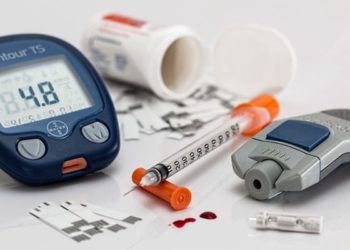Low brown fat may explain increased susceptibility to type 2 diabetes in south Asians
Image: PD
1. Brown adipose tissue (BAT) volume, as measured by 18F-FDG uptake after cooling, was significantly higher in Caucasian than south Asian participants.
2. Resting energy expenditure, which was positively correlated with BAT volume, was higher in Caucasian than Asian subjects.
Evidence Rating Level: 2 (Good)
Study Rundown: Brown adipose tissue (BAT) contributes to energy homeostasis via mitochondrial uncoupling to produce heat. Activated by exposure to cold, BAT is thought to contribute to non-shivering thermogenesis. This thermogenic property has made BAT an increasingly popular target for anti-obesity and anti-diabetes research, a hypothesis that has been bolstered by promising findings in recent studies in transcription regulation and animal models. South Asians are known to be especially susceptible to type 2 diabetes and tend to develop the disease at lower BMIs as compared to their Caucasian counterparts. To better determine the role of BAT in this heightened risk, the authors of this study compared South Asians to BMI-matched Caucasian controls in terms of BAT volume and activity. While the activity per unit volume of BAT was similar in both groups, BAT volume was lower in Asian participants.
This study suggests a possible mechanism for the south Asians’ increased vulnerability to type 2 diabetes and other metabolic consequences of high calorie, high fat diets. Future research should examine techniques for increasing BAT volume or activity as this may suggest new therapeutic options for the treatment of type 2 diabetes and metabolic syndrome. In this study, the sample size was small and all patients were young, healthy males, thereby limiting generalizability. Given the significant commitment and radiation exposure required of participants, it may be difficult to gather data about the function of BAT in a larger and more heterogeneous population.
Click to read the study in The Lancet
Relevant Reading: Brown adipose tissue oxidative metabolism contributes to energy expenditure during acute cold exposure in humans
Study authors Mariëtte Boon and Patrick Rensen talk to 2 Minute Medicine: Leiden University Medical Center in the Netherlands
“Our findings suggest that making more BAT or increasing its activity could have great therapeutic potential in south Asians, helping them increase the clearance of glucose and fatty acids and converting surplus white fat into heat, potentially lessening the risk of diabetes.”
They add, “It has recently been shown that BAT can be recruited in humans following 10 days of cold intervention. Future studies should be directed towards the efficacy of this strategy, as well as other options, such as medication, to increase BAT activity. These strategies might finally be used to improve the metabolic phenotype in south Asians.”
In-Depth [prospective, case-controlled study]: Dutch men of South Asian descent (n=12) were compared their BMI-matched Dutch Caucasian counterparts (n=12); participants were healthy and lean with an average age of 24. Exclusion criteria included rigorous exercise (>10 hours/week). In order to activate non-shivering thermogenesis by BAT, cooling mattresses were used to lower the temperature until shivering occurred; the temperature was then increased by 3-4 °C and cooling continued for 2 hours. To measure various metabolic parameters, venous blood samples were taken. To quantify BAT volume and activity, participants were injected with 18F-FDG after 1 hour of cooling and PET CT was performed after 2 hours. BAT activity was measured as a standard uptake value (SUV), which reflected activity per unit volume of BAT.
Although mean BMI did not differ between South Asian and Caucasian participants, Asian subjects were shorter and lighter with a higher body fat percentage. Prior to cooling, average resting energy expenditure was significantly lower in Asian than Caucasian participants; this difference persisted after controlling for lean body mass. The temperature at which shivering began was higher in Asian participants. Non-shivering thermogenesis significantly increased energy expenditure in Caucasian subjects (1689 kcal per day vs. 2027 kcal per day with cooling, p<0.0001); this was not observed in Asian participants (1296 kcal per day vs. 1462 kcal per day with cooling, p=0.09). Caucasians experienced a significantly greater increase in free fatty acid concentration with cooling compared to Asian participants (p=0.0046). Activity per unit volume of BAT, as detected by 18F-FDG uptake, did not differ between the two groups. However, BAT volume was significantly lower in Asian than Caucasian subjects (188mL vs. 287 mL, p=0.04). When all participants were considered, BAT volume was positively associated with resting energy expenditure (β=0·44, p=0·04).
By Hayley Walker and Mimmie Kwong
More from this author: Dual PDE3/PDE4 inhibitor may be effective treatment for asthma and COPD, Alefacept may be effective therapy in newly diagnosed type 1 diabetics, Key patient characteristics predict outcomes in children with cardiomyopathy, Remote ischemic preconditioning reduced myocardial injury in CABG patients
©2012-2013 2minutemedicine.com. All rights reserved. No works may be reproduced without expressed written consent from 2minutemedicine.com. Disclaimer: We present factual information directly from peer reviewed medical journals. No post should be construed as medical advice and is not intended as such by the authors, editors, staff or by 2minutemedicine.com. PLEASE SEE A HEALTHCARE PROVIDER IN YOUR AREA IF YOU SEEK MEDICAL ADVICE OF ANY SORT.





